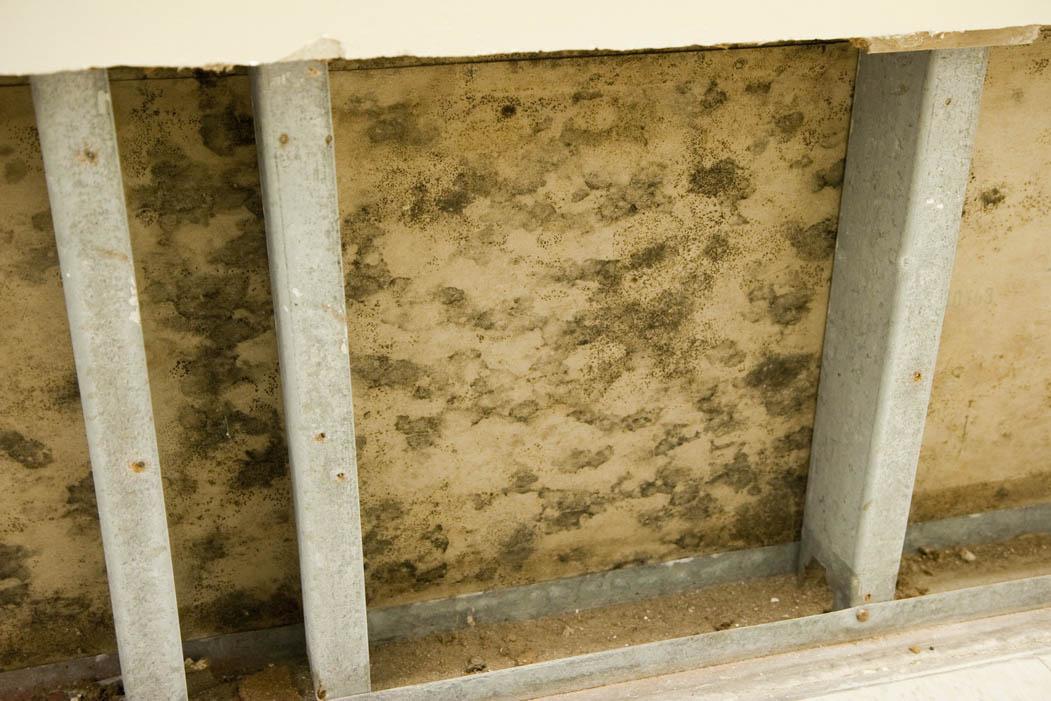Water damage will cost the music department thousands of dollars and is also forcing the journalism department to consider moving.
A week before the spring semester, university personnel found during a storm the music department’s practice rooms — located below the first floor — flooded with water. Peering into the rooms, facilities coordinator Colleen Ryan splashed through about 14-inches of water as she searched for equipment that workers could save.
Ryan and two others, piano technician Kathy Smith and administrative support assistant Arnel Ignacio, eventually wheeled out 22 pianos, which were placed in a nearby classroom with a heater to dry them out.
“They were kind enough to go in there and move stuff out,” said John Carnahan, director of the Bob Cole Conservatory and music department chair. “[Their efforts] saved the pianos.”
The music department didn’t escape water damage altogether.
Rainwater reached about 6 inches high in the practice rooms, basically damaging anything on the ground, Carnahan said. Consequently, carpets in the percussion rooms were destroyed.
Drums, stringed wooden-base instruments and fiberboard harp cases were also damaged, Carnahan said. He said the music department will not know the extent of the damage to the instruments until they dry out, which will be in about a month.
“As far as whether it’s a complete [equipment] loss, we can’t say yet,” Carnahan said.
He added, “Looks pretty good so far, but you never know.”
Carnahan said the damage can range anywhere from $2,000 for repairs to $40,000, should all the equipment be irretrievably damaged — although he doesn’t think that will happen.
Although there wasn’t flooding in the Social Sciences and Public Administration building, the water intrusion was a problem there, as well.
“The SSPA area had a few areas where water percolated up from under the slab. But the amount of water was not of ‘flood’ proportions, but a real concern nonetheless,” said Robert Quirk, director of Facilities Management.
Other areas affected by water damage include the Psychology building, Brotman Hall, the College of Business Administration, and the Family and Consumer Sciences building.
Quirk said costs associated with the storm — which include repairs, emergency response, and labor associated with preparation and clean-up — amount to $50,000.
Most facilities suffered water intrusion, and the damage was minor: wet carpet, wet ceiling tiles and mud intrusion.
“The campus provides extensive preventative measures in terms of maintenance to storm drains and roof drains, keeping trees trimmed and streets clear of debris,” Quirk said.
The flooding around campus due to the storms was a result of the incapacity of the drainage system, according to Quirk.
“This caused parking lots and roads to flood; a couple of cars were damaged,” he said. “The water then finds its way to the lowest points.”
According to David Salazar, associate vice president of Physical Planning and Facilities Management, the SSPA building suffered the “most severe water damage” since water seeped into the drywall. For that reason, wall panels were removed to allow ventilation.
Ventilation is a way to prevent the growth of mold in areas where there has been water intrusion. Employees from the Environmental Health and Safety department tested the SSPA building to gauge the moisture within the walls, and if the results are over a certain threshold, mold is present.
There is no mold present in the SSPA building, according to Salazar.
“It looks like a construction stain,” said Richard Johnson, occupational safety manager.
Johnson added that the university will test the water level to see if it is below 0.5 percent.
“It is possible that it is old material,” he said.
No changes in classes were necessary and for the most part, business is being conducted as usual, although an office in the journalism department was vacated due to ongoing water seepage from the ceiling, Quirk said.
The journalism department has faced these problems in the past because it is located in the basement of the SSPA building, which is the lowest point on campus, according to Salazar.
The water table in the area is particularly high, which means that the bottom floor of the SSPA building is practically at water level; with heavy rains, the level rises and eventually water is pushed up through the ground.
Due to the journalism department’s location and the presence of a high water table, this will continue to be “a chronic problem,” Salazar said. He said there hadn’t been a problem of this magnitude in the last four years, but these last series of storms were severe enough to cause water damage.
There is a continual need to upgrade the water proofing standards in the SSPA basement and for that reason, a water-proofing company will assess the building Tuesday to determine what type of preventative measures should be taken, Salazar said.
The perpetual threat of possible water damage is forcing the journalism department to look at a possibly moving.
“No decisions yet,” said David Dowell, vice provost and director of strategic planning. “We are working on it and expect to have a plan in the next few weeks.”
Trishian Bucheli contributed to this article.
This article was modified Feb. 16 at 5:40 p.m.




